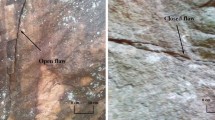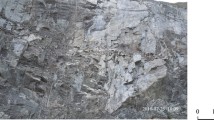Abstract
Crack propagation can gradually reduce the strength of the rock and eventually result in rock failure. Coupling effect of stress and seepage in fracture could accelerate the rock failure process. In this work, a set of water sealing device is developed to apply different fluid pressures in the pre-existing fracture in specimens made of rock-like material. We have carried out uniaxial compression tests on specimens at different pre-existing flaw dip angles (30°, 45°, and 60°) coupled with fluid pressures in the fracture. Through laboratory experiments and numerical simulations, we find that without fluid pressure in the pre-existing flaw, wing cracks and secondary cracks appear at the pre-existing flaw tips. With the increase of the fluid pressure in the flaw, the propagation of secondary cracks is restrained, no secondary cracks appear at the flaw tips. The increase of fluid pressure accelerates the wing crack propagation, inhibits the secondary cracks, and causes the specimen to undergo tensile failure. Compared with the specimen without the fluid pressure in the flaw, the fluid pressure in the flaw promotes wing crack initiation and propagation, and causes the initiation stress of the wing cracks and the peak strength of the specimens to decrease gradually. With or without fluid pressure in the fracture with the increase of the flaw dip angle, the initiation stress of wing cracks and peak strength of the specimen first decrease and then increase. When the pre-existing flaw dip angle is 45°, the peak strength and the initiation stress are the lowest.

















Similar content being viewed by others
Abbreviations
- \(a\) :
-
Half-length of the pre-existing flaw
- \(C\) :
-
Cohesion
- \(f_{i}\) :
-
Body force
- \(g_{x}\),\(g_{x}\),\(g_{x}\) :
-
Acceleration of gravity in the x, y, and z directions
- \(K\) :
-
Stiffness matrix
- \(M\) :
-
Mass matrix
- \(C\) :
-
Damping matrix
- \(K_{\rm I}\),\(K_{{{\rm I}{\rm I}}}\) :
-
Mode I and II stress intensity factor, respectively
- \(P\) :
-
Total nodal pressure
- \(p_{p}\) :
-
Seepage pressure
- \(Q(t)\) :
-
Loading vector
- \(u_{i}\) :
-
Nodal displacement
- \(\dot{u}_{i}\) :
-
Nodal velocity
- \(\alpha\) :
-
Angle between the minimum principal stress direction and the pre-existing flaw
- \(\rho\) :
-
Density
- \(s\) :
-
Nodal saturation
- \(\tau\) :
-
Shear strength
- \(\tau_{f}\) :
-
Shear stress on the crack surface
- \(\phi\) :
-
Internal friction angle
- \(\gamma\) :
-
Specific gravity
- \(\sigma_{1}\),\(\sigma_{3}\) :
-
Maximum and minimum principal stresses, respectively
- \(\sigma_{N}\),\(\sigma_{T}\) :
-
Normal and transverse compressive stresses, respectively
- \(\overline{\sigma }_{t}\) :
-
Tensile strength
- \(\sigma_{ij.j}\) :
-
The first-order partial derivative of the stress tensor
References
Alpern JS, Marone CJ, Elsworth D (2012) Exploring the physico-chemical processes that govern hydraulic fracture through laboratory experiments. In: Proceedings of at the 46th US Rock Mechanics/Geomechanics Symposium, Chicago, USA, 24–27 June 2012. ARMA 12–678
Bobet A, Einstein HH (1998) Fracture coalescence in rock-type material under uniaxial and biaxial compression. Int J Rock Mechan Min Sci 35(7):863–888
Bao JQ, Fathi E, Ameri S (2016) A unified finite element method for the simulation of hydraulic fracturing with and without fluid lag. Eng Fract Mechan 162:164–178
Choo LQ, Zhao Z, Chen H, Tian Q (2016) Hydraulic fracturing modeling using the discontinuous deformation analysis (DDA) method. Comput Geotech 76:12–22
Chen M, Pang F, Jin Y (2000) Experiments and analysis on hydraulic fracturing by a large-size triaxial simulator. Chin J Rock Mechan Eng 19(S1):868–872
Dehghan AN, Goshtasbi K, Ahangari K, Jin Y, Bahmani A (2017) 3d numerical modeling of the propagation of hydraulic fracture at its intersection with natural (pre-existing) fracture. Rock Mechan Rock Eng 50:1–20
Dyskin AV, Sahouryeh E, Jewell RJ, Joer H, Ustinov KB (2003) Influence of shape and locations of initial 3-d cracks on their growth in uniaxial compression. Eng Fract Mechan 70(15):2115–2136
Fu JW, Zhu WS, Zhang XZ, Shi LY, Xie FD (2017) Fracturing experiment and numerical simulation study on new material containing a hollow internal crack under internal water pressure. Adv Eng Sci 49(4):78–85
Fu JW, Zhu WS, Xie FD, Xue WQ, Zhang DF, Li Y (2013a) Experimental studies and elasto-brittle simulation of propagation and coalescence process of two three-dimensional flaws in rocks. Rock Soil Mechan 34(9):2489–2495
Fu JW, Zhu WS, Cao GH, Xue WJ, Zhou K (2013b) Experimental study and numerical simulation of propagation and coalescence-process of a single three dimensional flaw in rocks. J China Coal Soc 38(3):411–417
Guo BH (2010) Numerical analysis of hydraulic fracturing on single-holed rock specimens. Rock Soil Mechan 31(6):1965–1970
Jian H, Zhu WS, Li SC, Pu YB, Qi LF (2002) Rea1-time CT test of hydraulic fracture process for jointed rock masses. Chin J Rock Mechan Eng 21(11):1655–1662
Li LC, Tang CA, Li G, Wang SY, Liang ZZ (2012a) Numerical simulation of 3d hydraulic fracturing based on an improved flow-stress-damage model and a parallel fem technique. Rock Mech Rock Eng 45(5):801–818
Li SH, Feng C (2008) Continuum-based discrete element method and its applications. UK-China Summer School/International Symposium on DEM, Beijing, China, 24–30 September 2008. Paper 147–170
Li SC, Li TC, Wang G, Bai SW (2007) CT real-time scanning tests on rock specimens with artificial initial crack under uniaxial conditions. Chin J Rock Mechan Eng 26(3):484–492
Li SC, Yang L, Li MT, Zhang N (2009) Influences of 3d internal crack dip angle on tensile mechanical properties and fracture features of rock-like material. Chin J Rock Mechan Eng 28(2):281–289
Li XB, He XQ, Chen HJ (2012b) Crack initiation characteristics of opening-mode crack embedded in rock-like material under seepage pressure. Chin J Rock Mechan Eng 31(7):1317–1324
Li YP, Yang CH (2006) Influence of geometric characteristics of pre-existng cracks on mixed mode fractures under compression-shear mechanics and engineering. Chin J Rock Mechan Eng 25(3):462–466
Morgan SP, Einstein HH (2017) Cracking processes affected by bedding planes in opalinus shale with flaw pairs. Eng Fract Mech 176:213–234
Muskhelishvili (1953) Some basic problems of the mathematical theory of elasticity. Noordhoff, Leyden
Oda M (1986) An equivalent continuum model for coupled stress and fluid flow analysis in jointed rock masses. Water Resour Res 22(13):1845–1856
Wei C, Zhu WS, Li Y, Wang SG (2019) Experimental study and numerical simulation of propagation and coalescence process of inclined flaws and horizontal fissures in rocks. Rock Soil Mechan 40(11):4533–4542
Wong LNY, Einstein HH (2009) Crack coalescence in molded gypsum and Carrara marble: part 1. Macroscopic observations and interpretation. Rock Mechan Rock Eng 42(3):475–511
Yang Y, Yong-Ming Y, Ma S, Yang JU, Ying-Chun G, Yong YU (2013) Crack propagation induced by hydraulic fracturing in low permeability rocks using CT technology. J Min Safe Eng 30(5):739–743
Zhang B, Li SC, Xia KW, Yang YX, Zhang DF, Wang SG, Zhu JB (2016) Reinforcement of rock mass with cross-flaws using rock bolt. Tunneling Undergr Space Technol 51:346–353
Zhang B, Li SC, Xia KW, Liu JY, Guo S, Wang SG (2019) The coalescence and strength of rock-like materials containing two aligned X-type flaws under uniaxial compression. Geomechan Eng 17(1):47–56
Zhang B, Liu JY, Wang SG, Li SC, Yang XY, Li Y, Zhu PY (2018) Impact of the distance between pre-existing fracture and wellbore on hydraulic fracture propagation. J Nat Gas Sci Eng 57:155–165
Zhang DF, Li SC (2009) The modified tensile stress crack propagation criterion and influence of cranny hydraulic pressure on crack propagation. Chin J Comput Mechan 26:114–119
Zhang XP, Zhang Q (2017) Distinction of crack nature in brittle rock-like materials: a numerical study based on moment tensors. Rock Mech Rock Eng 50(10):2837–2845
Zhao YL, Cao P, Lin H, Liu YK (2008) Study on fracture mechanism and rheologic fracture failure criterion of compressive shear rock crack under saturated pressure. Chin J Geotech Eng 30(4):511–517
Zhou J, Chen M, Jin Y, Zhang GQ (2007) Experimental study on propagation mechanism of hydraulic fracture in naturally fractured reservoir. Acta Petrolei Sinica 28(5):109–113
Zhou QL, Liu GF (1982) Pressure shear fracture of brittle materials. J Hydraulic Eng 13(7):63–69
Zhou XP, Cheng H, Feng YF (2014) An experimental study of crack coalescence behaviour in rock-like materials containing multiple flaws under uniaxial compression. Rock Mech Rock Eng 47(6):1961–1986
Zhu WC, Liu J, Yang TH, Sheng JC, Elsworth D (2006) Effects of local rock heterogeneities on the hydromechanics of fractured rocks using a digital-image-based technique. Int J Rock Mech Min Sci 43(8):1182–1199
Acknowledgements
This work is funded by the National Natural Science Foundation of China (Nos. 51879151, 41672281, 51909142), and the Fundamental Research Funds of Shandong University (No. 2017JC001). These resources of support are gratefully acknowledged.
Author information
Authors and Affiliations
Corresponding authors
Additional information
Publisher's Note
Springer Nature remains neutral with regard to jurisdictional claims in published maps and institutional affiliations.
Rights and permissions
About this article
Cite this article
Wei, C., Zhang, B., Zhu, W. et al. Fracture Propagation of Rock like Material with a Fluid-Infiltrated Pre-existing Flaw Under Uniaxial Compression. Rock Mech Rock Eng 54, 875–891 (2021). https://doi.org/10.1007/s00603-020-02256-3
Received:
Accepted:
Published:
Issue Date:
DOI: https://doi.org/10.1007/s00603-020-02256-3




